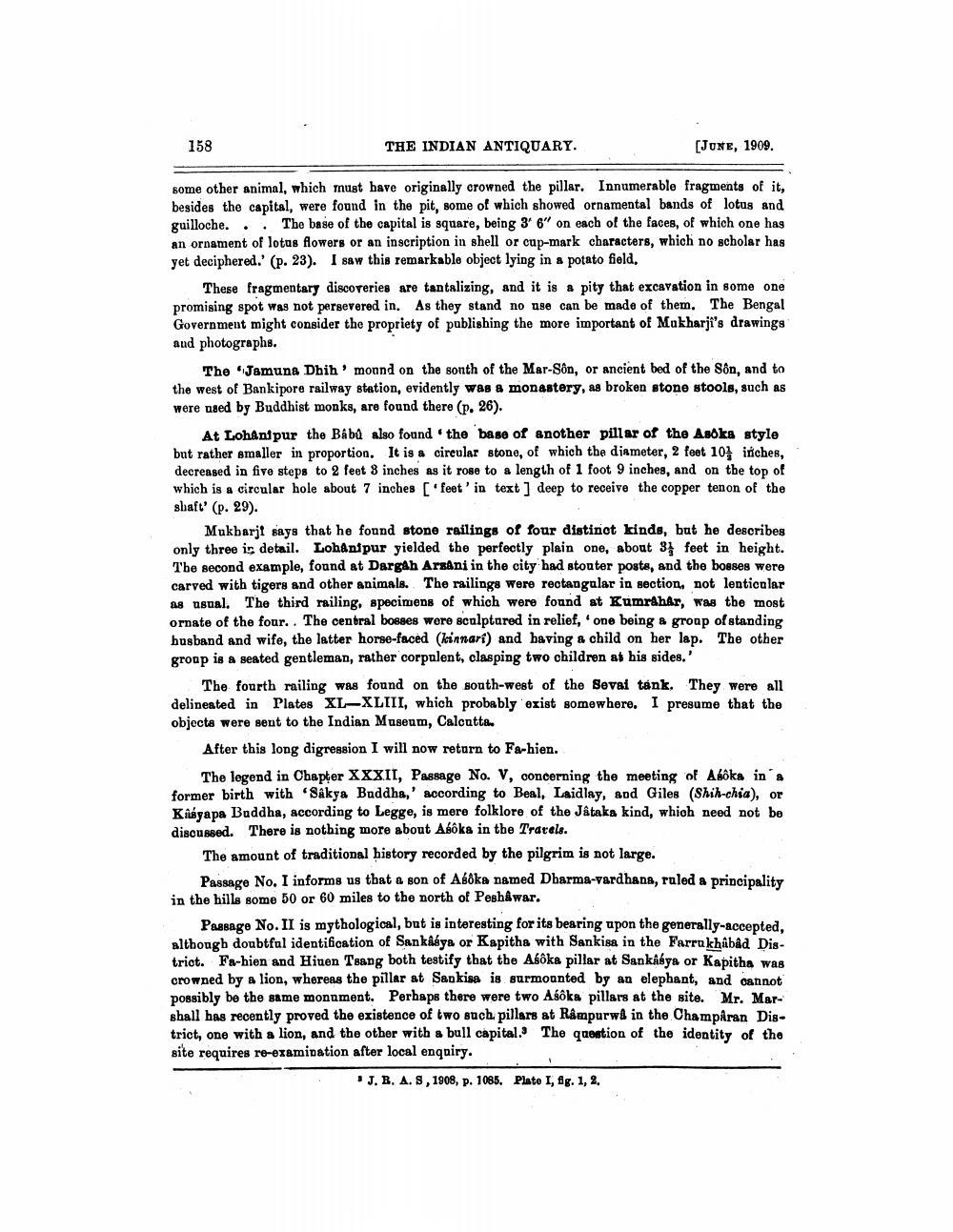________________
158
THE INDIAN ANTIQUARY.
[JUXE, 1909.
some other animal, which must have originally crowned the pillar. Innumerable fragments of it, besides the capital, were found in the pit, some of which showed ornamental bands of lotus and guilloche... The base of the capital is square, being 36" on each of the faces, of which one has an ornament of lotus flowers or an inscription in shell or cup-mark characters, which no scholar has yet deciphered.' (p. 23). I saw this remarkable object lying in a potato field,
These fragmentary discoveries are tantalizing, and it is a pity that excavation in some one promising spot was not persevered in. As they stand no use can be made of them. The Bengal Government might consider the propriety of publishing the more important of Mukharji's drawings and photographs.
The Jamuna Dhih mound on the sonth of the Mar-Sôn, or ancient bed of the Son, and to the west of Bankipore railway station, evidently was a monastery, as broken stone stools, such as were used by Buddhist monks, are found there (p. 26).
At Lohanipur the Babů also found the base of another pillar of the Asoka style but rather smaller in proportion. It is a circular stone, of which the diameter, 2 feet 10 inches, decreased in five steps to 2 feet 8 inches as it rose to a length of 1 foot 9 inches, and on the top of which is a circular hole about 7 inches [feet' in text ] deep to receive the copper tenon of the shaft' (p. 29).
Mukbarjt says that he found stone railings of four distinot kinds, but he describes only three is detail. Lohanipur yielded the perfectly plain one, about 3 feet in height. The second example, found at Dargah Arsani in the city had stouter posts, and the bosses were carved with tigers and other animals. The railings were rectangular in section, not lenticular as usual. The third railing, specimens of which were found at Kumrahar, was the most ornate of the four. . The central bosses were sculptured in relief, one being a group of standing husband and wife, the latter horse-faced (Kinnari) and having a child on her lap. The other group is a seated gentleman, rather corpulent, clasping two children at his sides.'
The fourth railing was found on the south-west of the Seval tank. They were all delipested in Plates XL-XLIII, which probably exist somewhere. I presume that the objects were sent to the Indian Museum, Calcutta.
After this long digression I will now return to Fa-hien.
The legend in Chapter XXXII, Passage No. V, concerning the meeting of Abôks in a former birth with SÅkya Buddha,' according to Beal, Laidlay, and Giles (Shih-chia), or Kisgapa Buddha, according to Legge, is mere folklore of the Jätaks kind, which need not be discussed. There is nothing more about Abôks in the Trarels.
The amount of traditional history recorded by the pilgrim is not large.
Passage No. I informs us that a son of Abdka named Dharma-vardhana, ruled a principality in the hills some 50 or 60 miles to the north of Peshawar.
Passage No. II is mythological, but is interesting for its bearing upon the generally-accepted, although doubtful identification of Sankaya or Kapitha with Sankisa in the Farrukhabad Distriot. Fa-hien and Hiuen Tsang both testify that the Abóka pillar at Sankhya or Kapitha was crowned by a lion, whereas the pillar at Sankisa is surmounted by an elephant, and cannot possibly be the same monument. Perhaps there were two Asôks pillars at the site. Mr. Marshall has recently proved the existence of two such pillars at Rampurwd in the Champiran District, one with a lion, and the other with a ball capital. The question of the identity of the site requires re-examination after local enquiry.
J. B. A. 9, 1908, p. 1085.
Plato I, fig. 1, 2.




